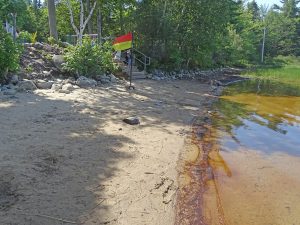
An unpleasant algal bloom in Sandy lake in early August of 2019 was an “early warning sign” that the lake is in a precarious state. View DRAFT Report On the State of Sandy Lake, the Historical Trends and its Future Trajectory (David Patriquin, Feb 23, 2021)
Good News!!! Yesterday, this motion was approved by the Environment and Sustainability Standing Committee:
That the Environment and Sustainability Standing Committee recommend that Halifax Regional Council direct the Chief Administrative Officer to adopt and implement a detailed water quality monitoring program based on Framework 1 as outlined by AECOM in their Water Quality Monitoring Policy and Program Development Report, as outlined in the Discussion section of the staff report dated May 6, 2021.
View Draft Minutes of the June 3 meeting
View Video of the ESSC meeting, June 3, 2021
So evidently the next step is for Halifax Regional Council to consider the recommendation.
More Details
View May 6, 2021 Staff Report. From that Report:
The proposed monitoring program would consist of sampling 74 lakes on an annual basis, with the number of sampling events determined based on lakes’ priority concerns and vulnerability (i.e. risk of harmful algae bloom, high chloride concentration, historical E. coli contamination, or other risks from land use). Class A lakes are listed as high vulnerability and Class b is moderate vulnerability. Water quality would be tested using routine parameters for lake trophic status, chloride levels, and important observational information such as ice in/out, presence of algae blooms, invasive species or nuisance aquatic plant growth. These baseline parameters, especially when collected over several seasons, and when compared to previous study findings, will provide the Municipality with a foundational understanding of lake health. This will be critical to informing management and land development strategies.
View Presentation: Lake Water Quality Monitoring Program (PDF, 12 slides)
View Halifax Regional Municipality Water Quality Monitoring Policy and Program Development
Prepared by: AECOM Canada Ltd., Sep 2020 99 pages + Appendices.
Sandy Lake is one of 25 Priority Lakes recommended in the AECOM (2020) Report for regular monitoring to represent one or more of three Water Quality vulnerabilities – chloride, eutrophication and bacteria.
Some components of the monitoring that would apply to Sandy Lake as a Class A/High Vulnerability Lakes as cited in AECOM (2020):
The core monitoring design is focused and includes monitoring of a single, fixed station in a central deep lake location, once in spring during mixed-water column conditions and once at the end of summer; additional stations for lakes with complex morphometry/distinct basins.
Frequency and Timing: 2-year rotation
Class A – High Vulnerability Lakes have 2 sampling events per year at each lake
• once in spring during mixed-water
column conditions
• once at the end of summerRoutine monitoring parameters are selected that provide strong indicators of eutrophication and chloride enrichment that can be compared against numerical objectives and targets. Routine parameters include:
• Secchi depth;
• Lake depth at the sampling location;
• Profiles of field measurements at 1-m depth intervals from the lake surface to 1-m off the lake bottom for standard parameters (i.e., temperature, pH, dissolved oxygen concentration, specific conductivity);
and
• TP concentration and Chlorophyll a (as a euphotic zone composite).Additional parameters or sampling that may be triggered to further assess water quality issues and inform potential modeling exercises, include:
• Chloride concentration — to be analyzed in a discrete sample collected at one metre off the lake bottom (1 MOB) – triggered if dissolved oxygen concentration is less than 1 mg/L and specific conductivity exceeds 450 microsiemens per centimeter (μS/cm) at 1 MOB in spring. This specific conductivity is approximately equivalent to the CWQG for chloride concentration of 120 mg/L for the protection of aquatic life from chronic exposure (see Chloride Enrichment section below).
• TP concentration (1 MOB) — to be analyzed in a discrete sample collected at 1 MOB — triggered if dissolved oxygen concentration is less than 1 mg/L at 1 MOB at end-of-summer.
The spring and end-of summer profile sampling especially welcomed, as that is what’s needed to detect possible impairment of spring turnover at Sandy Lake by salt stratification, as discussed in the DRAFT Report On the State of Sandy Lake, the Historical Trends and its Future Trajectory (David Patriquin, Feb 23, 2021).
